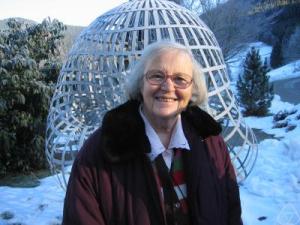
Yvonne Choquet-Bruhat is a French mathematician and physicist, renowned for her pioneering work on the initial value problem of General Relativity. Her work was one of the “Milestones of General Relativity” featured in a recent CQG focus issue. She has been on the faculty of the University of Marseille, the University of Reims and the University Pierre-et-Marie-Curie in Paris. She was the first woman to be elected to the French Academy of Sciences and is a Grand Croix of the Legion of Honour of France. She is also an elected member of the American Academy of Arts and Sciences. This reminiscence of Einstein was presented at the conference “A Century of General Relativity” held in Berlin, 30 November to 5 December, 2015. This image of Yvonne Choquet-Bruhat has been obtained from Wikipedia where it was made available by Momotaro under a CC-BY-SA 2.0 license. It is included within this article on that basis and attributed to Oberwolfach Photo Collection.
I met Einstein in 1951 at the Institute for Advanced Study in Princeton. I was making there a postdoctoral stay, as assistant to the great mathematician Jean Leray, a part-time permanent professor at the IAS. I had defended a thesis on General Relativity under the official direction of André Lichnerowicz, but it was Jean Leray who had encouraged me to attack the problem of the existence of solutions of the Einstein equations taking given initial values, without assuming their analyticity. When I told Lichnerowicz about Leray’s suggestion, he said “it is too difficult for a beginner”. In fact it was not so difficult. In harmonic coordinates, called then “isotherm”, introduced by Lanczos, DeDonder and Georges Darmois, the Einstein equations in vacuum look like a system of quasidiagonal, quasilinear system of second order partial differential equations hyperbolic for a Lorentzian metric. I found by chance an article written in French by Continue reading


You must be logged in to post a comment.